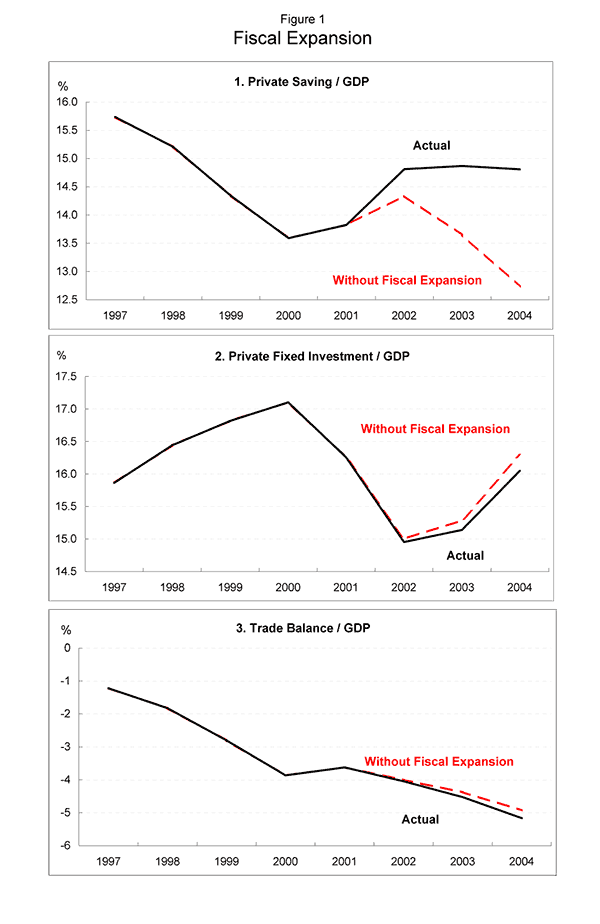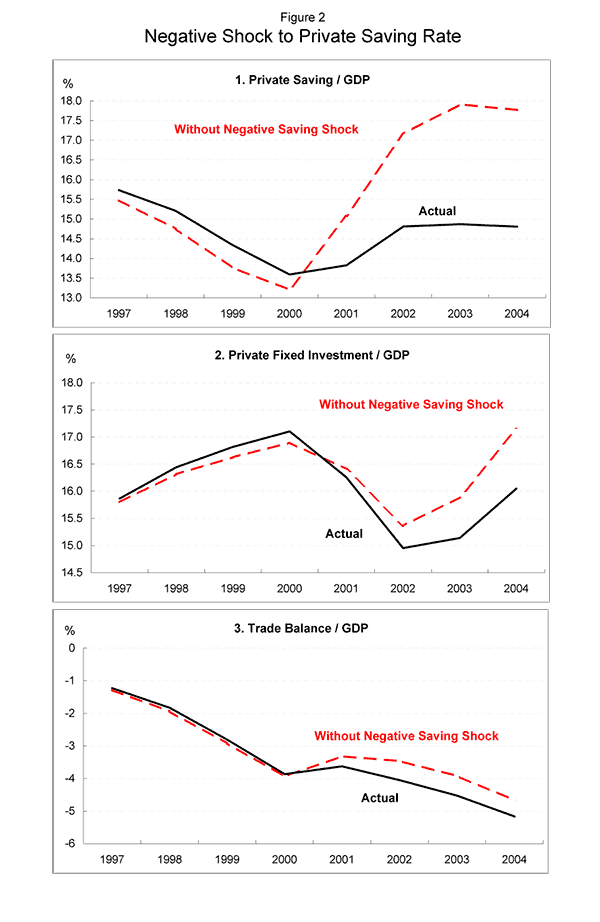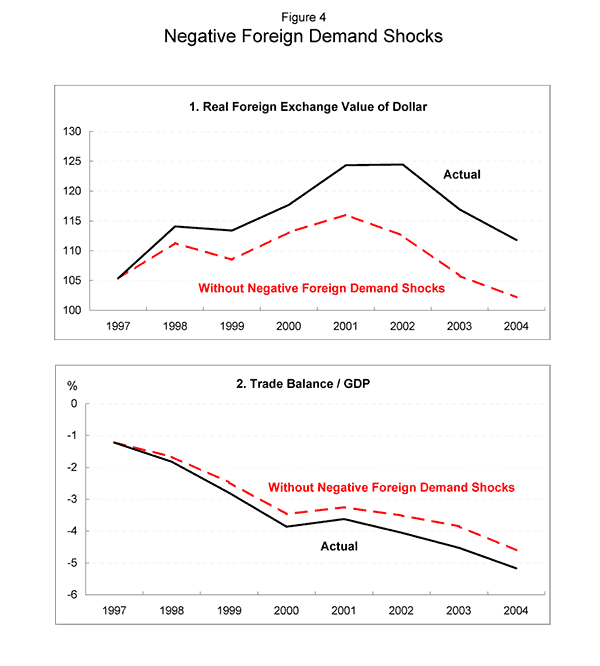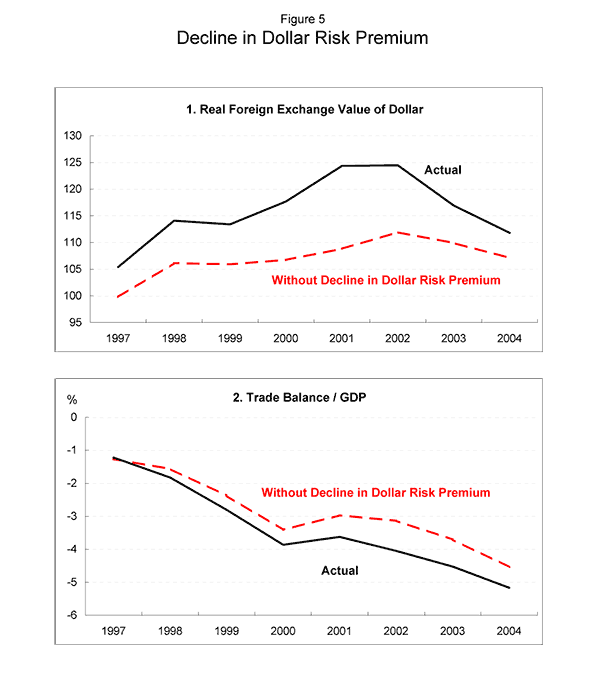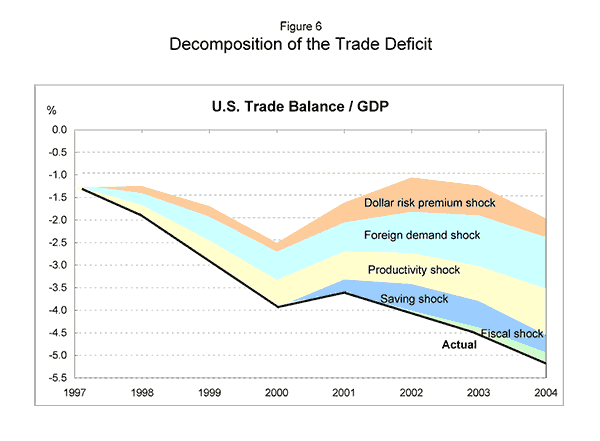I would like to address an issue that is receiving increasing attention lately: the U.S. current account deficit. Not since joining the Federal Reserve Board have I seen this topic show up in the financial press as frequently--and so often with such ominous overtones--as it does these days. Several reasons for this come to mind. Most obviously, at about 6 percent of gross domestic product, the current account deficit is now larger than it has ever been in our nation's history; that, by itself, attracts attention. Also, because the current account deficit reflects the excess of our country's imports over our exports, the deficit's descent into record territory has helped crystalize fears that the economy is losing competitiveness and that U.S. jobs and incomes are suffering as a result. Finally, the larger the current account deficit becomes, the greater the number of observers who believe that a correction, and one with significant implications for the U.S. economy, is imminent. Such expectations have contributed to, and in turn have been reinforced by, the slide in the dollar over the past few years.
Although views differ as to when a correction will take place, nearly all agree that the current trajectory of the U.S. current account deficit is unsustainable. This consensus reflects the simple logic that the deficit is causing the net indebtedness of the U.S. economy to rise more rapidly than U.S. income. In 1985, our foreign assets were about equal to our foreign liabilities, so that our net international investment position was roughly zero. By 1995, our investment position had deteriorated to negative 4 percent of GDP, and by 2004, we estimate this negative position to have reached about one-fourth of GDP. If current account deficits continue to boost the negative international investment position, eventually the cost of servicing that position, which so far has been quite modest, would rise to an unsustainable level. Obviously, the current account would have to adjust to ensure that excessive debt burdens are not maintained.
If nearly all observers agree that an adjustment of the U.S. current account deficit is inevitable, few agree on when the adjustment will occur and what will cause it to happen. Many argue that U.S. households must raise to a more prudent level a saving rate that has fallen to less than 3 percent of disposable income in recent years. Others place the onus of adjustment on foreign economies to boost lackluster domestic demand and increase their purchases of U.S. exports. While some call upon coordinated governmental action to address the pattern of global external imbalances, others place their faith in market mechanisms to do the job.
A large part of the reason that people disagree about what will be needed to bring about current account adjustment is that they disagree about what has led the deficit to become so large in the first place. If one believes that the expansion of the current account deficit has been caused by government policies, such as budget deficits, then it is natural to identify a reversal of those policies as the action that will bring about current account adjustment. Conversely, if the current account deficit primarily reflects developments in the private sector, it is more likely that the marketplace will be the source of subsequent correction.
Surprisingly, researchers have made relatively few attempts to assess and compare the full range of explanations that have been proposed for the emergence of the large U.S. external deficit.1 In my remarks today, I would like to survey some of the factors that have been put forward to explain the deficit. As I do so, I will be referring to several macroeconomic model simulations, implemented by my colleagues on the Federal Reserve Board's staff, that are designed to gauge the impact of these factors on the U.S. external imbalance. The proposed causes of the deficit are by no means mutually exclusive, of course. It is possible and even likely that the deficit is the outcome of several different developments. I should also note at the outset that the views I will express are my own and do not necessarily reflect those of my colleagues in the Federal Reserve System.
Approaches to Characterizing the Current Account
Before getting to
these explanations, however, I'd like to take a few moments to clear up what--for
some, at least--has been a prominent source of confusion. At least
three approaches characterize the current account balance, and each of them
shines the spotlight on different factors that may be influential.
Perhaps most commonly, the current account balance is portrayed as the difference between a nation's exports, broadly defined, and its imports. From this perspective, the determinants of the current account balance are roughly the same as the determinants of the trade balance: exchange rates, prices, and incomes at home and abroad. Accordingly, the widening of the U.S. current account deficit is frequently attributed to the strengthening of the dollar since the mid-1990s, which led U.S. imports to be cheaper measured in dollars and U.S. exports to be more expensive in foreign currency.
According to a second perspective, the current account balance is defined as the difference between a nation's saving and its investment. This definition highlights the decline in the ratio of national saving to GDP over the past ten years, even as investment rates have moved up a bit on balance, as the central cause of the widening of the U.S. current account deficit.
Finally, because any excess of national spending over income must be financed by foreigners, the current account deficit is equivalent to the net inflow of capital from abroad. This approach points to the surge of capital inflows into our economy as the key development underlying the emergence of the large external deficit.
These three approaches--the trade balance, the saving-investment balance, and net capital inflows--might, at first blush, appear to attribute the emergence of the large U.S. current account deficit to highly distinct factors. In reality, however, these approaches are merely three alternative means of characterizing the outcomes of the same underlying, fundamental developments. To see this more concretely, consider, for example, the effects of a rise in investor perceptions of the rate of return on investment in the United States. The rise will likely attract foreign capital inflows. It may also lead to a strengthening of the dollar, thereby weakening exports and strengthening imports. Finally, through various channels, the rise in the perceived rate of return may boost the investment rate and lower the saving rate.
In this example, the fundamental shock causing the current account deficit to widen is the change in investor expectations. The other elements of the story--the inflow of capital, the strengthening of the dollar, and the movements in saving and investment rates--represent diverse aspects of the economy as they respond to that initial shock and lead, ultimately, to the larger deficit. The story can be played out using any of the three approaches to the current account that I have reviewed. To be sure, some approaches may be more helpful in highlighting certain types of shocks than others. But any compelling explanation of the current account deficit must identify not merely the proximate influences on the deficit--be they exchange rates, capital flows, or aggregate saving and investment--but also the fundamental, underlying sources of the imbalance.
Explanations for the Large U.S. Current Account Deficit
I would like now to address five different explanations for the large
U.S. current account deficit, and even these do not exhaust the possibilities.
The first three explanations focus primarily on domestic developments: the
fiscal deficit, an autonomous drop-off in private saving rates, and the surge
in productivity growth. The remaining explanations encompass developments
abroad as well: the slowdown in foreign demand and the apparent rise in global
financial intermediation. I will not discuss yet another factor that
undoubtedly has contributed to the widening of the deficit--the
rise in oil prices--but it is worth noting that our oil import bill
has risen by about $110 billion, from $68 billion in 1999 to $180 billion in
2004, and most of this increase reflects higher oil prices.
1. Expansion of the fiscal deficit
The view that the current account deficit arises from the widening U.S. budget deficit has received considerable attention of late and recalls the discussion of the mid-1980s, when the simultaneous emergence of fiscal and current account deficits in the United States gave rise to the "twin deficits" hypothesis. The simplest version of this hypothesis starts with the identity that the current account balance is equal to saving minus investment. Since the expansion of the fiscal deficit lowered public saving, the story runs, it must have lowered national saving and thus widened the current account balance to a similar extent. This version of the story is a bit too simple, however, as it assumes that private saving and investment remain constant, whereas in reality these quantities can and probably will change in response to a change in the fiscal balance. In the more sophisticated version of the story, a larger fiscal deficit boosts domestic demand, pushing up domestic interest rates relative to foreign rates; this, in turn, attracts investors and raises the value of the dollar, thereby leading to a larger current account deficit.
In theory, the fiscal explanation of the current account deficit is entirely plausible. In practice, however, the support for this proposition is weak. The United States has had episodes in which the fiscal and current account balances moved together, but it has also had episodes in which they diverged. Most notably, the fiscal factor cannot explain the widening of the trade deficit in the late 1990s, when the U.S. budget moved into surplus. At the international level, countries such as Japan and Germany are running large current account surpluses even as their budget balances are substantially in deficit. More generally, research into the determinants of current account balances has produced only mixed support for the linkage between fiscal and current account deficits.2
Why don't the reductions in public saving associated with widening fiscal deficits lead more consistently to higher current account deficits? Most likely, larger budget deficits increase the government's draw on available credit and dampen private consumption and investment spending, thereby limiting the deterioration of the current account. This explanation is supported by a simulation of the Federal Reserve Board staff's macroeconomic model, to which I alluded earlier. The results of this simulation, depicted in figure 1, suggest that, compared with a scenario in which no fiscal expansion had taken place, the loosening of fiscal policy since 2001 boosted the rate of private saving and lowered the rate of private investment. Accordingly, the effect on the trade deficit is estimated to have been fairly small.3 Rather than crowding out net exports, fiscal expansion appears to have primarily crowded out private investment and consumption.4
In sum, the recent experience both of the United States and of other countries, as well as the results of model simulations, lead me to conclude that the budget deficit has probably been only a small factor in the emergence of the large U.S. external imbalance. Of course, even if it does not narrow the current account deficit by much, reducing the budget deficit would be highly desirable for other reasons: It would free up resources for private investment, and it would reduce the burden on future taxpayers of repaying the federal debt.
2. Decline in the private saving rate
For observers who view the large current account deficit as an example of the profligacy of Americans, the sharp decline in private saving rates looms as large in their thinking as the sharp rise in the budget deficit. Since the mid-1990s, the personal saving rate has declined from roughly 5 percent of disposable income to less than 2 percent, and gross private saving (which includes corporate saving) has edged down from about 16 percent of GDP to less than 15 percent.
As I noted earlier, it is important to distinguish between fundamental shocks affecting the current account and other developments which might merely represent economic responses to those shocks. On one hand, the decline in private saving could reflect a response to other developments in the economy--for example, a rise in the value of equity holdings and housing wealth, increases in expected future income, or declines in interest rates--and thus might not represent a fundamental cause of the U.S. current account deficit. On the other hand, the decline in saving rates could reflect a structural shift in household saving and spending behavior. Continued financial liberalization and innovation have made it easier for Americans to borrow, particularly against their real estate wealth, and this easing may have led to greater consumption.
If Americans have experienced a structural decline in private saving rates, how much of the widening of the external imbalance could this explain? As shown in figure 2, the answer provided by our macroeconomic simulation model is: not much. The reason is virtually the same as in the case of a rise in fiscal deficits. According to our simulation, high private consumption boosts GDP growth and--all else equal--forces up interest rates; although the rise in interest rates strengthens the dollar, it leads to much lower investment spending. Accordingly, and as in the case of a fall in public saving, a fall in private saving appears to crowd out investment more than it crowds out net exports, and thus leads to little change in the trade balance. I should note, however, that just as a decline in the budget deficit is desirable even if it would not substantially reduce the trade deficit, a rise in private saving rates also would be helpful because it would strengthen private balance sheets and provide additional resources for investment and growth.
3. Productivity growth
In both the fiscal story and the private-saving story, the large U.S. current account deficit implicitly is the outcome of a rise in consumption relative to income. The third story I'd like to discuss highlights a more impressive achievement of the U.S. economy, the surge in labor productivity growth from about 1-1/2 percent annually in the two decades preceding 1995 to roughly 3 percent in the period since then. This surge is viewed as having several important consequences. First, higher productivity growth boosted perceived rates of return on U.S. investments, thereby generating capital inflows that boosted the dollar. Second, these higher rates of return also led to a rise in domestic investment. Finally, expectations of higher returns boosted equity prices, household wealth, and perceived long-run income, and so consumption rose and saving rates declined. Under this explanation, all of these factors helped to widen the current account deficit.
I find this story compelling. It links two key economic developments of the past decade: the rise in productivity growth and the widening of the current account deficit. It also helps to explain several other important developments, including the fall in U.S. saving rates and the 1990s boom in asset prices. In fact, a simulation of our macroeconomic model shown in figure 3 suggests that the surge in productivity growth, while hardly explaining all of the deterioration in the trade balance since the mid-1990s, accounts for more of that deterioration than do the public and private saving shocks combined.
Moreover, the effect of higher productivity growth on the trade balance could have been even larger than the simulation indicates because it likely worked through several channels that the model does not incorporate. The simulation does not fully take into account the rise in stock prices and household wealth--and hence, consumption--that would have been spurred by expectations of higher productivity growth. Also, because the simulation does not fully account for the effect of enhanced perceptions of equity returns on exchange rates, it does not produce the rise in the dollar that, in all likelihood, resulted from the productivity surge.
4. Slump in foreign domestic demand
I would like to turn now to developments at the global level that may have helped to widen the U.S. current account deficit. Domestic demand growth has slumped in many foreign economies because of varying combinations of an increase in saving rates and a decline in investment. This weakening of foreign spending has enhanced the supply of capital available to the United States, put downward pressure on U.S. interest rates, and put upward pressure on the dollar.
As I said before, I like the U.S. productivity surge story and find it compelling. However, I also like the foreign demand slump story, and I find it compelling. Some of the largest industrial economies in the world--Japan and the euro area--have been running current account surpluses while experiencing very subdued growth. In the developing world, the East Asian economies that went through financial crises in the late 1990s have seen a plunge in their investment rates even as their saving rates have remained extremely high; the weakness in domestic demand has likely motivated the authorities in these countries to keep their exchange rates competitive to promote export-led growth, a strategy that has also contributed to the U.S. external deficit.5 More generally, since 1999, the developing countries as a whole have been running current account surpluses--with the industrial countries, mainly the United States, necessarily running current account deficits--for the first time in many years.
What does our macroeconomic simulation model say about the likely effect of a slump in foreign consumption and investment spending? The slump lowers the path of foreign GDP, which in turn limits U.S. export sales. Additionally, by depressing perceived rates of return abroad, the weakness in foreign demand explains a considerable portion of the run-up in the dollar, as shown in figure 4. Finally, weaker U.S. net exports reduce overall U.S. activity and depress interest rates a bit, thus raising domestic consumption and investment spending. Taken together, these factors contribute importantly to the widening of the trade deficit since the mid-1990s.
5. Improvements in global financial intermediation
Another global factor that has been cited as contributing to the widening of the U.S. current account deficit has been an increase in global financial intermediation. Some suggest that home bias--the disinclination of investors to invest outside their own country--has been eroding and that this trend has permitted larger current account imbalances to be financed than would have been possible previously. This hypothesis is supported by the reduced correlation of national saving and investment rates in recent years, which implies that savings increasingly are being used to finance investment in other countries.6 Of course, an increased capacity of global financial markets to finance current account deficits does not, by itself, mean that it is the United States that would tap this enlarged capacity. However, observers suggest that the United States' unusually favorable investment climate, protections of investor rights, and prospects for rates of return made it likely that once international financing constraints were lifted, the U.S. economy would enjoy larger capital inflows.
So, how much of the enlargement of the U.S. current account deficit can we attribute to improved international intermediation? This is difficult to answer because it is hard enough to measure a concept as amorphous as international financial intermediation, let alone to gauge its effect on the current account. As a step in this direction, however, we reasoned that any reduction in home bias by foreign investors toward the United States would show up as a decline in the risk premium these investors demand for holding U.S. assets. This decline in the risk premium, in turn, would lead to a greater demand for U.S. assets and a rise in the dollar.
Based on an estimate of the decline in the risk premium that occurred since the mid-1990s, our macroeconomic model suggests, as shown in figure 5, that the decline contributed importantly to the rise in the dollar, and, therefore, to the widening of the trade deficit. Assuming that the lower risk premium can be attributed to growing international intermediation, this latter development apparently exerted an important influence on the U.S. current account.
Putting It All Together
I would now like
to step back and consider the relative contributions to the trade deficit of
each of the explanations I have discussed, as shown in figure 6.7
To the extent that the contributions of these shocks are reasonably well
measured by the macroeconomic model simulations, the most important message I
draw from them is that no single factor constitutes a dominant explanation of
the deterioration in the U.S. current account balance. That said, our model
accords the greatest roles to increased productivity growth, which has made the
United States a magnet for foreign saving, and to the slump in foreign domestic
demand, which has led to an excess of saving in those economies. The narrowing
of the risk premium on dollar assets appears to explain a bit less of the
widening of the trade deficit, with the loosening of fiscal policy and
reduction of private saving making still-smaller contributions. Of course,
these results are the product of our model-based analysis, with all of the
strengths and weaknesses that model simulations entail; it would be useful to
complement these findings with more direct historical and empirical analysis of
the U.S. external imbalance.
Attributing the historically unprecedented widening of the trade deficit, as well as the similarly unprecedented rise in our international indebtedness, to the coincidence of many random and unrelated developments would not make for a very satisfying story. However, my sense is that many of the developments that contributed to the U.S. trade deficit are not unrelated and may be part of a broader evolution of the global economy. The same types of liberalization and innovation that have improved financial intermediation within the United States, for example, have likely been instrumental in reducing home bias and increasing intermediation among countries. Improvements in financial markets, both at home and abroad, may have amplified the effects on the U.S. current account of other developments I have discussed, including the U.S. productivity surge and the perceived weakening of foreign investment opportunities. It is even possible that the expansion of the U.S. budget deficit would have been smaller had policymakers perceived global financial markets to be less willing to finance the gap.
The view that the current account deficit stems from economic developments that are varied and yet intertwined has important implications for how the deficit will be corrected. Such a view suggests to me, first, that government policies such as budget-cutting or encouragement of private saving are unlikely, by themselves, to correct the current account deficit, much as they might be desirable for other reasons. Such policies probably do not address all or even most of the root causes of the current account deficit.
However, the fact that I have deemphasized government policy as the source of the adjustment process does not mean that the public sector has no role to play. Reducing our budget deficit can ease the adjustment process by releasing resources that can be channeled into higher net exports, so that a reduced trade deficit does not require a curtailment of investment. The public sector in several nations has an important role in creating flexible markets for products, labor and financial assets. Appropriate macroeconomic and structural policies in many economies can contribute to the private-sector adjustment process by fostering an environment of innovation, increased productivity and more-rapid growth of domestic demand. Recognizing the role for public policy, the Group of Seven industrial nations recently stated that vigorous action is needed to address global imbalances and foster growth.
The primary impetus toward adjustment of the U.S. current account deficit, when it occurs, likely will come from private markets. Here, however, the multiplicity of factors underlying the large U.S. current account deficit raises questions about how that adjustment will come about. Some of the developments that may have supported the expansion of the U.S. current account deficit might reverse themselves--foreign domestic demand could recover, U.S. private saving rates could rise. And some of the factors that boosted the U.S. trade deficit, such as higher productivity growth or financial innovations that support greater spending, may show up more fully in foreign economies. Notably, all of these developments would take time to restrain the deficit, and any one of them, by itself, might have only a small effect. A final possibility is that, as U.S. deficits widen and foreign claims on the United States mount, actions by investors to re-balance their accumulation of assets could lead to changes in exchange rates, interest rates, and other asset prices that might contribute to a reversal of the deficit.
To the extent that the adjustment of the U.S. current account is driven by fundamental changes in the global economy, it is less likely, in my view, to be disruptive or disorderly. Our own experience with external adjustment in the 1980s was comparatively orderly, and so was the experience of many other industrial economies undergoing adjustment in recent decades.8 Of course, should adjustment prove disruptive to sustainable growth and stable prices, the Federal Reserve will certainly be prepared to act. However, my sense is that the implications of current account adjustment for U.S. economic growth and inflation will most likely be benign.
Footnotes
1. Analyses of the widening of the deficit include, among others, Catherine L. Mann (2002), "Perspectives on the U.S. Current Account Deficit and Sustainability," Journal of Economic Perspectives, vol. 16 (Summer), pp.131-52; and Nouriel Roubini and Brad Setser (2004), "The U.S. as a Net Debtor: The Sustainability of the US External Imbalances," (679 KB PDF) unpublished paper. Return to text
2. Much has been written on the relationship between the fiscal and current account balances. Recent work include Edwin M. Truman (2004), "Budget and External Deficits: Not Twins but the Same Family," (159 KB PDF) paper presented at the Annual Research Conference, held at the Federal Reserve Bank of Boston, June 14-16; Mathieu Bussiere, Marcel Fratzscher, and Gernot J. Muller (2004), "Productivity Shocks, Budget Deficits and the Current Account," unpublished paper, European Central Bank, November; and Christopher J. Erceg, Luca Guerrieri, and Christopher Gust (2005), "Expansionary Fiscal Shocks and the Trade Deficit," International Finance Discussion Paper 2005-825 (Washington: Board of Governors of the Federal Reserve System, January). Return to text
3. The trade balance accounts for nearly all of the deterioration in the current account balance and is the component of the current account that is most reliably analyzed by the model. The other components of the current account balance consist of net investment income, other income flows, and transfers. Return to text
4. This result is consistent with other model-based analyses of the effect of fiscal policy on the current account, including Erceg, Guerrieri, and Gust, "Expansionary Fiscal Shocks." Return to text
5. Investment rates in some of the major East Asian developing economies, excluding China, plunged more than 10 percentage points of GDP after their peak in the mid-1990s and generally stayed depressed thereafter. A desire to offset this loss of domestic demand, as well as to rebuild their foreign exchange reserves, are likely reasons that authorities in the region intervened to stem upward pressures on their currencies. See Steven B. Kamin (2005), "The Revived Bretton Woods System: Does It Explain Developments in Non-China Developing Asia?" (253 KB PDF) paper presented at the conference "The Revived Bretton Woods System: A New Paradigm for Asian Development?" held at the Federal Reserve Bank of San Francisco, February 4. Return to text
6. Declines in the correlation of investment and saving across countries are documented in Olivier Blanchard and Francesco Giavazzi (2002), "Current Account Deficits in the Euro Area: The End of the Feldstein-Horioka Puzzle?" Brookings Papers on Economic Activity, 2:2002, pp. 147-209; and Joseph Gruber (2004), "Increased Current Account Dispersion: Differential Growth, Demographic Dispersion, or Greater Financial Integration?" unpublished paper, Board of Governors of the Federal Reserve System, December. Return to text
7. The contributions to the trade deficit shown in figure 6 do not precisely match those shown in figures 1 through 5 because of the non-linearity of the model. Return to text
8. See Hilary Croke, Steven B. Kamin, and Sylvain Leduc (2005), "Financial Market Developments and Economic Activity during Current Account Adjustments in Industrial Economies," International Finance Discussion Paper 2005-827 (Washington: Board of Governors of the Federal Reserve System, February). Return to text

